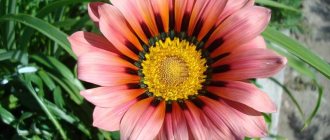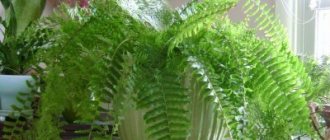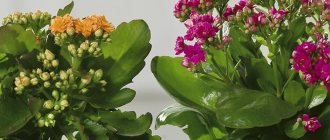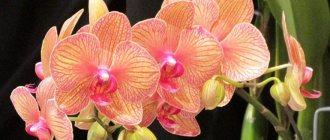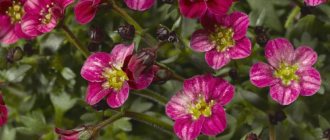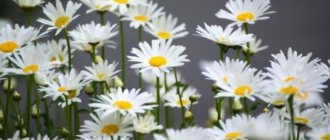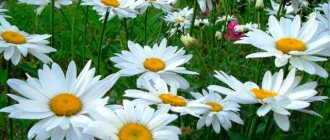Terry perennial chamomile is a plant that gives the garden a spectacular appearance. The culture harmonizes perfectly with various flowers in the flowerbed. However, it looks best against the background of low plants. In order for a plant to have a decorative appearance, it needs to be properly cared for.
Terry perennial chamomile has excellent decorative properties.
What does a garden chamomile look like?
Garden chamomile, or cornflower, has a thin but strong stem 30-100 cm high with bipinnate dark olive leaves. The top is decorated with large inflorescences up to 15 cm in diameter, which are collected from flowers without reeds and reeds in white and yellow shades.
Garden chamomile
In the center of the flower there is a yellow core. The petals are large, arranged in 1-2 rows. In terry varieties, the petals are arranged in several rows. After flowering, small fruits with cylindrical seeds up to 2 mm in size appear in the center of the plant.
Which family does it belong to?
Garden chamomile is a perennial or annual plant of the Asteraceae or Compositae family. Thanks to the work of breeders, a large number of varieties have been developed that differ in flower size and color, bush height, and frost resistance.
Briefly about the history of appearance
America is considered the birthplace of chamomile. It was discovered by Christopher Columbus during the discovery of the continent. The flower appeared in Russia in the 19th century, but it was called belyushka and vorozhka.
In Egypt, chamomile was considered a medicinal plant; an infusion from the flower had antipyretic properties. The Egyptians believed that the flower was created by the ancient god Ra. The Scandinavians and Germans considered the flower sacred and offered it to the main Deity Odin.
For your information! Tibetan sages believe that chamomile is the elixir of youth.
Plant characteristics
Compared to wild-growing specimens, garden chamomile has a number of advantages. These include:
- large flowers;
- regular formation of buds;
- long flowering period;
- reappearance of flowers in midsummer.
Plant with seeds or seedlings
Stages:
- sowing time for seedlings is March-April, you can sow directly in open ground in June;
- the seedling box is filled with soil;
- the seeds are mixed with sand and distributed over the surface of the substrate, moistened well, covered with film;
- as soon as the shoots appear (after 7-10 days), the film is removed;
- water as the top layer of soil dries;
- daylight hours 12-15 hours;
- in the phase of 3 true leaves, seedlings are picked
Stages:
- Seedlings are planted in a permanent place according to a 25x30 cm pattern;
- water every other day;
- shelter from direct sunlight;
- on depleted soils, feed with organic matter 1-2 times per season;
- water in hot weather 1-2 times a week;
- faded inflorescences are cut off;
- before winter, all shoots are shortened, leaving 10 cm
Classification of popular types
Rose Geisha (Geisha) - growing features
Chamomile is divided into several types, but the most popular are: meadow chamomile, Kuril nivaria, marsh and greatest. They are all similar in appearance, but have certain differences:
- flower size;
- place of growth;
- bush height;
- flowering duration.
Meadow chamomile (Leucanthemum vulgare)
A perennial plant up to 90 cm high. The plant forms single inflorescences-baskets with a diameter of 6-7 cm. The marginal petals are snow-white, single-row, the small core is lemon-colored. Flowering begins in June and lasts about 1.5 months. Grows in meadows and open forest clearings.
Kuril cornflower (Leucanthemum kurilense)
The plant is small and grows in the east. The Kuril and Japanese islands are considered its homeland. Grows on stones, cliffs, sandy seashores. Kuril nivet reaches a height of 20 cm; at the beginning of flowering, a single inflorescence-basket appears on the plant, with white single-row petals and a yellow core. The diameter of the flower is about 8 cm.
Swamp cornflower (Leucanthemum paludosum)
This species grows in southern Spain and Portugal. The plant has a second name - marsh chrysanthemum. The bush is small, reaching a height of up to 25 cm. The inclined or erect shoots are covered with rich green, alternately arranged leaves. At the beginning of June, the bush is covered with lush inflorescences-baskets, small in size. Flowering lasts until the first frost.
Swamp cornflower
Leucanthemum maximum
A beautiful flowering species that arrived in Russia from the Pyrenees. The plant forms a large number of shoots up to 100 cm and a shortened rhizome. The inflorescences are large, reaching a diameter of up to 12 cm. There are double and semi-double chamomile. The snow-white petals are arranged in several rows, as a result the flower looks fluffy and resembles a chrysanthemum.
This species differs from others in its late flowering. The first inflorescences appear in the second half of July and last until the first frost. The species has a drawback - it is fragility. Due to prolonged flowering, the plant spends a lot of energy, as a result the flower becomes smaller and weaker.
Important! This variety is not resistant to unfavorable conditions, so it needs regular updating.
Thanks to the work of Russian scientists, the largest variety of cornflower – Pobeditel – was developed. It is resistant to sudden temperature changes and long flowering. The tall bush forms large inflorescences, 12 cm in size. The variety is unpretentious and grows in one place for about 10 years.
Botanical description
Terry white chamomile is considered one of the varieties of chrysanthemums. It is an ornamental perennial that begins to bloom at the end of June. The process continues until the first ten days of autumn, so it makes dacha owners very happy.
- According to the description, the culture is characterized by large white flowers.
- The stem can reach a length of 50-100 cm.
- The inflorescences have a diameter of 10-12 cm.
The culture is considered very thermophilic and loves sunny areas.
The plant has difficulty responding to lack of lighting. Under such conditions, the bushes begin to wither and become less fluffy, and the flowers decrease in size.
The plant is characterized by large flowers.
Varieties most popular with gardeners
There are a large number of varieties of garden nivaria. There are varieties of terry perennial chamomile, and there are annual varieties with simple inflorescences. But only a few are the most popular. They differ from each other in the shape of the inflorescences, the height of the bush, and the duration of flowering.
Alaska
Peony Buckeye Belle (Paeonia Buckeye Belle) - growing features
The most popular variety of large chamomile. The plant forms a bush 80 cm high. Inflorescences are up to 12 cm in diameter. The variety is unpretentious and drought-resistant. Seeds are planted in open ground in the fall so that the plant will enjoy flowering the following year.
Important! The first flowering occurs in the first half of June, the second occurs in the fall.
Alaska
Princess
A low-growing variety that blooms throughout the warm period. The plant forms a small spreading bush up to half a meter high. Blooms profusely and for a long time with regular watering. Bush chamomile, at the beginning of summer the plant is covered with numerous inflorescences with a diameter of 10 cm. Against the background of short shoots, the flowers look quite large. Flowering lasts about a month, but to prolong flowering it is necessary to promptly pick off faded inflorescences.
Princess
North Star
The variety is considered a favorite among perennial garden daisies. The plant got its name because of its snow-white silver inflorescences-baskets with thin, pointed petals. When planted in a sunny place, the bush grows 16 cm wide and reaches a height of up to 40 cm. The variety is winter-hardy and easily tolerates Russian frosts.
North Star
Stern von Antwerp
The giant bush is covered with inflorescences 10 cm in diameter. The core of the flower is yellow, and the reed flowers are snow-white. For long-term flowering, the plant is planted in a sunny place with nutritious soil.
Stern von Antwerp
Beethoven
A perennial plant up to 80 cm high. In June, single, simple inflorescences-baskets measuring 12 cm in size appear on the bush. The flowers have snow-white petals and a golden core. The variety is suitable for cutting, single and group plantings.
Beethoven
Schwabengrub
The variety forms a huge bush 80 cm high. During flowering, the plant is covered with large, double flowers. The variety is winter-hardy and is grown in seedlings for rapid flowering.
Little Princess
The low-growing variety is suitable for decorating borders and edging flower beds. Chamomile is small, garden, reaches a height of 20 cm. The first flowering occurs in the second half of June, the second in August. The basket inflorescences reach 5 cm in diameter.
Maxima Koenig
Perennial herbaceous plant up to 1 meter high. The inflorescences are large, 10-12 cm in diameter, with a bright golden core and two-row snow-white reed petals. The variety blooms in June-July.
Maxima Koenig
Sans Souci
The plant forms a meter-long bush with 12 cm inflorescences. Around the yellow core there are white or yellow petals arranged in several rows. The variety is winter-hardy, propagated by seeds and by dividing the bush.
Sans Souci
May Queen
The variety is popular among Russian flower growers for its unpretentiousness and frost resistance. The compact bush reaches a height of up to half a meter. Against the background of dark olive glossy foliage, single snow-white basket inflorescences look attractive. It blooms 2 years after planting the seeds; to see early flowering, the variety is grown in seedlings.
May Queen
There are many flowers similar to the daisy, but they have different colored petals. Such plants include:
- feverfew, summer residents often call it perennial red chamomile;
- erigeron or perennial pink chamomile.
Important! These colored varieties will look harmonious in combination with garden chamomile. In addition, they have the same conditions of detention and care rules.
Characteristics of terry chamomile varieties
Terry petunia - variety description
Among the abundance of types of terry chamomile, varieties that have their own individual characteristics are especially popular.
French chamomile
The plant is one of the most winter-hardy among the orders of the Astrov family.
It loves moist soil and is planted in open ground. The inflorescence is 11 cm. A distinctive feature is that it blooms from May until the onset of frost.
French chamomile
Daisy Goldfinch
The variety has golden, double flowers with narrow, dissected petals. Blooms from early June until the first frost (mid-October). The height of the bush is about 50 cm. It tolerates the lack of light especially poorly. Looks good in group plantings.
Daisy Goldfinch
Chamomile Nivyanik
Another name is Crazy Daisy chamomile. The stem grows around 70 cm. The petals of Crazy Daisy are elongated, dissected, and soft. The flowers are snow-white, chrysanthemum-like in shape. It grows on loose soils and requires a lot of light and space. Loves feeding. In May, it is recommended to first plant in a greenhouse, and in June - in open ground.
Chamomile Nivyanik
Chamomile Chrysanthemum
The variety is distinguished by a large single inflorescence. Diameter – 12 cm. Petals are soft to the touch, fragile. The plant is winter-hardy and does not require much light.
Chamomile Chrysanthemum
Chamomile Edelweiss
It is considered the flower of true love and happiness. The scientific name is Leontopodium. Tolerates severe frosts. The flowering period ranges from early June to late August. The appearance of the inflorescence resembles a lush lion's paw. Loves moist soils and does not require much light.
Chamomile Edelweiss
Chamomile Fiona Goghill
A densely double, pom-pom-like plant. Diameter – 8 cm. Height – about 50 cm. Blooms from early June to August. For normal development of chamomile, fertile soil, well moistened, is required. Loves fertilizers and top dressing.
Chamomile Fiona Goghill
Romashka Real Knight
The flowers are spoon-shaped (narrow in the middle, widening towards the edges). Arranged in 2 or 3 rows. The stems are massive, length – about 40 cm.
Romashka Real Knight
They are not winter hardy, but have increased disease resistance. Blooms in July. Feels good in open sunny areas.
Chamomile Little Lady
Reaches only 15 cm in height.
Chamomile Real Glory
Plant height – 75 cm. The marginal flowers are pure white, the tubular ones are pale yellow. Flowers with a diameter of 11 cm. Long flowering begins in June and lasts until the end of October. Has increased resistance to diseases and pests.
Chamomile Real Glory
How does garden chamomile reproduce?
Peonies in a pot - features of growing ornamental plants
Chamomile is propagated by dividing the bush and seeds. Both methods are easy to implement, so even a novice gardener can handle them.
Growing from seeds
You can grow chamomile using seedlings or without seedlings. If you don’t have time to tinker with seedlings, seeds can be sown before winter or early spring. But it will be more effective to use the seedling method.
Time to board
Sowing seeds for seedlings is carried out in early or mid-March. The sowing time depends on climatic conditions: in the south, seeds can be sown in February, in regions with long winters - in late March and early April.
Selection of capacity
The seed is planted in a container or in separate cups. A separate container has a number of advantages:
- there is no need to pick;
- During transplantation into open ground, the root system will not be injured.
Before sowing the seeds, the container is scalded with boiling water or disinfected with a strong solution of potassium permanganate.
Preparing soil and seed
The prepared containers are filled with nutritious soil. You can buy it at the store, or you can make it yourself. To do this, turf soil is mixed with sand and peat in a ratio of 2:1:1. Before placing in containers, the soil is disinfected.
The seeds are buried 1.5 cm, sprinkled with earth and spilled. To ensure rapid seed germination, cover the container with polyethylene and put it in a warm place. If the temperature and humidity conditions are maintained, the first shoots will appear in 10-14 days.
Seedling care
After the seedlings emerge, the shelter is removed and the seedlings are transferred to a cooler place. Watering is carried out as the soil dries out. To avoid flooding the plant, it is better to irrigate it using a spray bottle.
In spring, seedlings often lack sunlight. Therefore, to prevent it from stretching, it is necessary to install additional lighting.
Seedling
Dive and transfer
When the seedlings reach 5 cm, they are thinned out and transplanted into separate containers. Since the root system of chamomile is fragile, picking should be done extremely carefully. In order for the bush to be powerful and spreading in the future, the seedlings are pinched above 3-4 leaves.
Dividing the bush
Perennial varieties are not recommended to be grown in one place for no more than 5 years. At the end of the period, the adult plant is divided into a certain number of divisions in the last days of September. Young bushes are immediately placed in prepared spilled holes.
Important! Experienced flower growers recommend dividing the bush annually to ensure that the flowers are large and the bush is powerful.
Advice from flower growers
Masters of their craft have a couple of tricks that help grow magnificent double daisies on the site:
- If the soil is acidic, then do not despair. Before planting, it is enough to carry out alkalization by adding 300 g of lime and dolomite flour per 1 m².
- Immediately before planting, flower fertilizer is poured into the hole, which can be purchased in specialized stores.
- At the beginning of flowering, for maximum lush buds, the plant is fed with a solution of potassium sulfate, superphosphate, 20 g per 10 liters.
- To extend the life of cut terry daisies for sale, experienced gardeners feed them with soda (3/4 teaspoon diluted in a liter of water). This will help get rid of bacteria and maintain a presentable appearance.
Attention! Do not overdo it with soda - it will destroy the plant.
- For abundant germination, mulch the soil with dry grass and sawdust.
- Nielweed grows in one place for no more than 7-8 years. Strong growth harms the plant’s immunity and the quality of flowers. Therefore, every 2-3 years it is necessary to rejuvenate terry chamomile by dividing the bushes.
Terry daisies are flowers that look fresh in bouquets, maintaining their original appearance and pleasant aroma for a long time. Using the information from this article, even a novice gardener will be able to get many beautiful and lush buds of this plant on his site.
Features of garden care
Seedlings are transplanted into open ground at 1.5 months of age, after the threat of return of spring frosts has passed. When planting in a permanent place, the plant should form a powerful root system and a strong stem. Planting and caring for large perennial garden chamomile is not difficult; it involves watering, fertilizing and removing faded inflorescences.
What conditions do daisies like?
Chamomile in the garden prefers to grow in a sunny place, with neutral or limestone soil. Before transferring seedlings to the flower garden, it is important to prepare the planting hole in advance. To do this, the soil is dug up and fertilized with a mineral complex. A hole is dug to a depth of 20-30 cm, and the interval between plantings is maintained at about 40 cm.
The seedlings are removed from the pot by transfer and placed in the hole. The plant is covered with earth, the top layer is compacted and spilled.
What is the plant afraid of?
Chamomile is an unpretentious plant, but if agrotechnical rules are not followed, flowering will not last long. The plant will grow and develop poorly:
- in the shade - the inflorescences will be small and the flowering will not last long;
- when grown in an area with shallow groundwater - since chamomile has a shallow root system, with constant contact with water the roots will begin to rot and the plant will die.
Watering
Immediately after transplanting the seedlings to a permanent place, they need regular watering. But after the plant takes root and begins to grow, irrigation is reduced and carried out only in severe drought.
Mulching
To retain moisture and stop the growth of weeds, the soil is mulched. Peat, straw, and mown grass are used as mulch.
Mulch will retain moisture
Loosening
After each irrigation, to avoid the appearance of an earthen crust, the soil is loosened. But since the root system is located superficially, loosening should not be deep so as not to damage the fragile roots.
Feeding
Feeding is carried out annually. Fertilizers are applied 2 times a year:
- In early spring, ammonium nitrate is scattered between the bushes (20 g per 1 m²).
- When buds appear, urea, diluted strictly according to the instructions, is added under bushes with faded leaves.
Important! Fertilizer is applied only to moist soil. Otherwise, the plant may get root burns.
Transfer
An adult bush is replanted by division every 5 years. But in order for the plant to be powerful and the inflorescences to be large, it is better to carry out the procedure annually. The transplant is carried out in cloudy weather, in the last days of September.
Planting chamomile in open ground
What time to plant seedlings
The grown seedlings should be transplanted into the soil after 1–1.5 months have passed from the moment of germination. Also, the threat of frost should pass outside. To plant garden chamomile, you need to choose a well-lit area with direct sunlight and neutral or calcareous soil. Groundwater must lie quite deep.
Disembarkation
Before planting daisies, you need to prepare the area. To do this, you need to dig it up, adding complex fertilizer for flowers. The depth of the holes should be from 20 to 30 centimeters, while a distance of 20 to 40 centimeters should be maintained between the bushes. The distance between the holes, as well as their depth, directly depend on the plant variety. The plant must be carefully pulled out of the cell with a lump of earth and placed in a hole. After this, it is covered with soil, and the surface is compacted a little. Then watering is done. The daisies will begin to bloom next year.
When and how does it bloom
Flowering time depends on the variety. Late ones bloom in mid-July, early ones show their inflorescences in the first half of June.
Types of flowers
Chamomile flowers can be semi-double or double, with thin, wide, straight and curved petals. In semi-double, snow-white petals are arranged in 1-2 rows, in terry - they are arranged densely, which makes the flower lush and even more attractive.
Flower shapes
Chamomile flowers are in the form of hemispherical inflorescences-baskets, with a diameter of 2 to 12 cm. They are collected in corymbs. In the center there are bisexual tubular flowers of canary color, on the sides there are white or yellow sterile pseudolingulate flowers.
Flowering period
Chamomile blooms profusely and for a long time. The beginning of flowering depends on the variety. The early ones bloom in June, the late ones in the second half of July. For all varieties, flowering ends with the arrival of the first frost.
Changes in care during the flowering period
During the flowering period, watering is reduced to a minimum. Irrigation is carried out only in dry weather. In order for inflorescences to appear regularly on the plant, it is recommended to remove dried flowers in a timely manner.
Nielberry diseases
With frequent and abundant watering, daisies suffer from fungus, rust or powdery mildew. For treatment, a one percent solution of Bordeaux mixture is used. Plants are sprayed with it at least 4 times.
You should also avoid the appearance of slugs and snails on the bushes. Nivyanik is a delicacy for them. Get rid of pests using a weak coffee solution.
The choice of garden daisies is huge. Nivyanik will perfectly complement areas equipped with stone and wood. These flowers will add zest and a touch of romance to the landscape of any garden.
Care after flowering
After flowering, care consists of collecting seeds and pruning the bush. Seeds remain viable for 2-3 years.
Chamomile seeds
Collecting seeds
To collect the seed, you need to wait until the large flowers are completely dry. After this, they are laid out in a dry, well-ventilated place to dry. When the inflorescences are completely dry, the seeds are removed from the central tubular flowers onto paper. After purging from foreign debris, the seed is poured into a paper bag and put away in a dark, dry place.
Important! Terry and varietal daisies cannot be propagated by self-collected seeds, since the future plant will not retain its parental characteristics.
Preparing for winter
Despite the fact that garden chamomile is cold-resistant, it is better to prepare it for wintering in the first year. For this:
- The plant is watered abundantly and fed with potassium-phosphorus fertilizers.
- The entire above-ground part is cut off, leaving stubs of 5 cm.
- For the winter, the roots are covered with sawdust, dry leaves or non-woven material.
An adult, strong bush does not need shelter for the winter. The exception is regions with harsh climates.
Plant propagation rules
Double daisies can be propagated by seeds or by dividing the bush. Seeds need to be planted directly into the ground.
However, in this case, the plant will achieve the desired decorative effect only in the fall. Therefore, seeds are most often used for growing seedlings.
Dividing the bush is considered a more effective method of propagation. With its help you can get a decorative flowering bush in a short time.
The plant fits perfectly into landscape design.
Possible problems in growing
In order for garden chamomile to rarely get sick, it is necessary to properly care for it. Because if agricultural practices are not followed, pests and diseases may appear on the foliage.
Pests
If weeds are not removed in a timely manner, the following may appear on chamomile: aphids, thrips, and star-winged flies. The drug Actellik will help get rid of the first two. Spraying is carried out strictly according to the instructions. The fly will go away on its own after weeding the flowerbed.
Diseases
The following diseases can appear from fungal diseases on chamomile:
- powdery mildew - a white coating appears on the foliage;
- gray rot - the leaf plate is covered with dirty fluff;
- rust – rusty spots form on the surface of the sheet;
- fusarium - leaves and stems turn brown. Without treatment, the plant dries out and dies.
Copper-containing preparations and a strong infusion of laundry soap will help get rid of the fungus.
Rust
Signs of improper care
Often, novice gardeners are faced with poor chamomile flowering. This can happen with improper care. The most common mistakes:
- the plant is planted in shade or partial shade;
- the soil is highly acidified;
- groundwater is located superficially;
- faded inflorescences are not removed in a timely manner;
- the soil is severely depleted;
- thickened planting.
Garden chamomile is an ornamental, large-flowered plant. Miniature and powerful bushes show basket-shaped inflorescences from June until the first frost. At the dacha, chamomile is planted singly or in groups, along borders or in combination with bright perennials.
Pests and diseases of daisies
With insufficient or irregular care, chamomiles have a chance of developing powdery mildew, gray mold, rust and fusarium.
Powdery mildew appears as a whitish coating on the above-ground parts of the plant, which gradually turns brown.
Rust appears as dark red spots on the upper side of the leaves, and on the lower side it forms pads with fungal spores.
Fusarium is also a fungal disease, in which the roots and root collar of young plants begin to rot, the tissues become brown, the stem becomes thinner, and the leaves turn yellow.
Gray rot is manifested by rapidly increasing in size brown necrotic spots on shoots and leaves. At high air humidity, the spots are covered with gray mycelium fluff.
To prevent fungal infection of flowers, do not allow excess moisture in the soil, promptly remove weeds and loosen the soil. It is better to immediately remove a specimen infected with gray rot so that the disease does not spread to neighboring plants.
They destroy fungal microflora with fungicides - Fundazol, Topaz, Kuproxat, Oksikhom and other drugs of similar action. Treatment is carried out two or three times with an interval of 7-10 days.
Among the pests, garden chamomile is affected by aphids, thrips, star-winged flies and wireworms.
The star-winged fly is so named because of the small star-shaped spot on its wing. Its larvae damage garden chamomile, accumulating at the base of the middle flowers. You can protect the planting of daisies from the appearance of this pest by regularly destroying weeds on the site.
Thrips and aphids are sucking insects that feed on the cell sap of the above-ground parts of the plant. Discolored or yellow spots, streaks and stripes appear on the leaves, damaged tissues die, leaves wither, fall off, flowers become deformed and lose their decorative effect. In the fight against aphids and thrips, insectoacaricides are used - Karbofos, Agravertin or Actellik.
Wireworms are the larvae of click beetles . They live in the soil for up to four years and feed on underground parts of plants. To get rid of them, traps are set in the soil: holes are dug into which pieces of potatoes, carrots or beets are placed. The top of the trap is covered with a board or piece of metal. After 2-3 days, the traps are opened and the wireworms that have accumulated in them are destroyed. This needs to be done regularly. Most often, wireworms appear if there is a plot of potatoes nearby.
Growing edelweiss: characteristic features
It won't be difficult. But be aware, under no circumstances should you plant it next to gladioli, roses, or peonies, because the flower is not visible against their background.
Alpine slides are often decorated with edelweiss. Indeed, among the stones that are an obligatory attribute of such landscape compositions, he feels at home.
What soil is suitable
Leontopodium needs sunlight, you need to choose the right place for planting. Suitable for growing on dry, light calcareous soils. To bring conditions closer to natural, it is advisable to add coarse sand or crushed stone to the soil before planting.
A peculiarity of the garden “Queen of the Alps” is the negative perception of nutritious soil. Why can a plant say goodbye to its decorativeness?
It tolerates poor soils and crevices between stones much better. It is strictly prohibited to use mineral or organic fertilizers for fertilizing, especially the application of fresh manure. And it is preferable to minimize root loosening of the soil. It is also important to avoid stagnation of moisture in the soil. This will be facilitated by the addition of drainage crushed stone and sand during planting.
Following these simple recommendations will contribute to better and faster acceptance of the plant and its further growth.
Care: transplanting, weeding, wintering
Creeping plants will be bad neighbors, because the growth of its roots is suppressed by the strong and persistent root system of creeping plants, until the complete death of the Queen of the Alps.
Therefore, it is necessary to promptly control weeds on the site and planted mountain pets
Although Leontopodium is quite frost-resistant, before the cold weather arrives, the bushes are often mulched using wood material or peat.
Mulch helps maintain the integrity of the snow cover over dormant plants, protecting them from freezing.
Description and features of edelweiss
There are many legends around the Alpine star. According to one of them, a girl who lived high in the mountains fell in love with a young man from the lowlands. However, they were not allowed to meet each other, and the young maiden, approaching the edge of the cliff, shed bitter tears down. In the place where they fell, flowers of unusual beauty grew, which are still associated with love and fidelity. The plant is also an unspoken symbol of climbers. Already in our time, the International Union established the Order of Edelweiss, which was awarded to the best climbers.
Leontopodium (lat. Leontopodium) is a herbaceous crop from the genus Dicotyledons, belonging to the Asteraceae family. They are annual or perennial flowers growing in small bushes. Their height ranges from 10 to 35 cm, the stems are straight, covered with narrow lanceolate leaves, which form a dense rosette at the base. The inner side of the leaf blades is densely pubescent, which allows the plant to retain moisture, and the outer side is painted in a silver-gray hue.
Alpine star is the second name for edelweiss
Edelweiss blooms from June to July, producing complex star-shaped inflorescences. They consist of several tubular baskets of yellow or white color and marginal needle-shaped petals of a snow-white color. All petals are covered with short fluffy pile, which makes the flower seem to be slightly crushed by snow.
Distribution and habitats
Leontopodium is a resident of the alpine and subalpine zone. In the wild, it grows at an altitude of at least 1.8 km, inhabiting rocky mountain slopes (Alps, Himalayas, Carpathians, Tibet). Some varieties are found in Siberia, Mongolia, and sometimes even Korea. There, the culture also grows exclusively on rocky terrain.
Chemical composition and beneficial properties
By studying the biochemical composition of edelweiss, scientists have discovered many useful components. So, the green part of the plant contains:
- ascorbic acid;
- vitamins A and K;
- trace elements (K, Ca, Mg);
- tannin;
- antioxidants.
Herbal remedies based on leontopodium have an antibacterial effect, relieve inflammation, relieve cramps, remove phlegm and harmful substances. The plant also has immunostimulating, tonic properties, helps relieve nervous tension, and alleviate the effects of stress.
Edelweiss essential oil is used in cosmetology
Collection, preparation and storage of raw materials
Edelweiss is listed in the Red Book as an endangered species, and therefore folk healers use flowers grown on their plots. Harvesting is done in the summer, when Leontopodium blooms. Using sharp scissors, carefully cut the stems and hang them to dry in the shade. The finished raw materials are laid out in fabric or paper bags, where they are stored for no more than 3 years.
Application in medicine
Tibetan monks were the first to use the beneficial properties of the Alpine star. They treated diseases of the respiratory system, gastrointestinal tract, as well as cardiovascular problems with the plant. The chemical components that make up edelweiss help lower blood pressure, relieve joint pain, and remove stones from the bile ducts. To slow down the aging process, the flower is often used in the manufacture of anti-aging cosmetic products.
Harm and contraindications
Unlike other medicinal crops, Leontopodium does not contain harmful substances and is also not toxic. There are no strict contraindications to it. People with individual intolerance, pregnant and lactating women need to be careful.
Propagate by seeds and dividing the bush
Stages:
- several large inflorescences are left to obtain seeds;
- cut when they and the stem itself are completely dry;
- dry at home for 1-2 weeks;
- stored in breathable bags
Stages:
- a two or three year old chamomile bush is dug up in mid or late August;
- carefully divide and immediately plant in a new place;
- Before winter, young bushes have time to take root and do not require additional shelter
Agricultural technology
When choosing this crop for a site, its characteristics should be taken into account. Each section has its own nuances.
Landing
The soil for planting should be loose and moist. The place is sunny and open. A month before planting, you need to plow, fertilize the soil with mineral or organic additives, and make small holes for planting.
Attention! Almost all varieties require a lot of light. If there is not enough of it, the plant will quickly wither.
There are 3 planting methods:
- The seedless method. Seeds are planted in open, prepared soil at the end of May or beginning of June. Since the seeds are small, they need to be lightly sprinkled with soil. After 2-3 weeks, the first shoots appear. After 3-5 leaves appear on the plants, daisies are planted 2 at a distance of 40 cm. If the variety is late, then terry chamomile will bloom in early autumn, early ones - in the second year of life.
- Seedling method. Popular method of reproduction. In early spring, seeds are sown in deep pots with loose soil and drainage. First, moisten the soil a little. After planting, the seeds are sprayed with water from a spray bottle, covered with film, and placed on a sunny tray. Planted in May, when the soil has warmed up well to a depth of 40 cm.
- Method of dividing a bush. An adult plant is divided every 3-4 years. In September or mid-spring, the plant is dug up and divided into 2-3 parts. Divided bushes are planted at a distance of 30-40 cm and watered.
